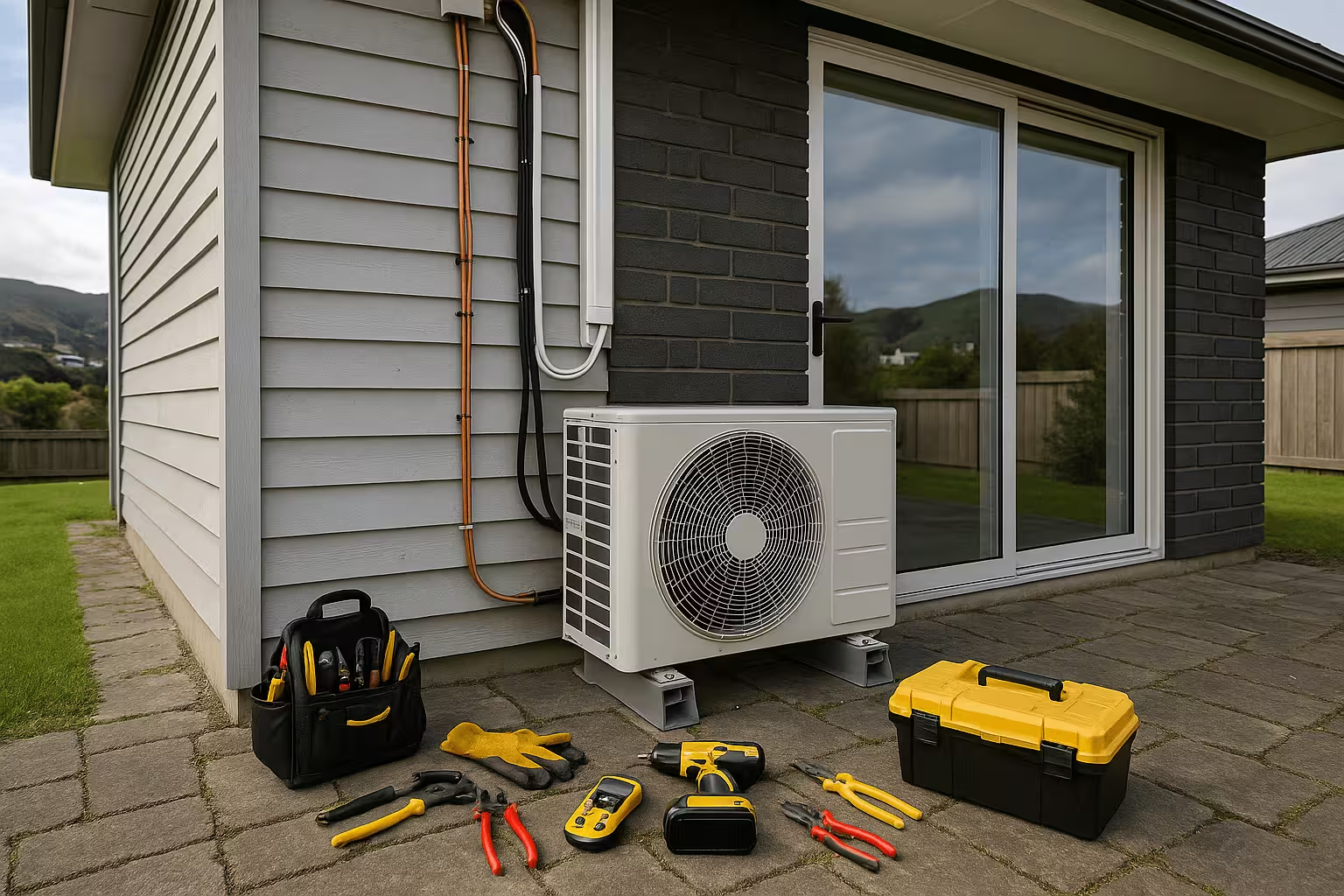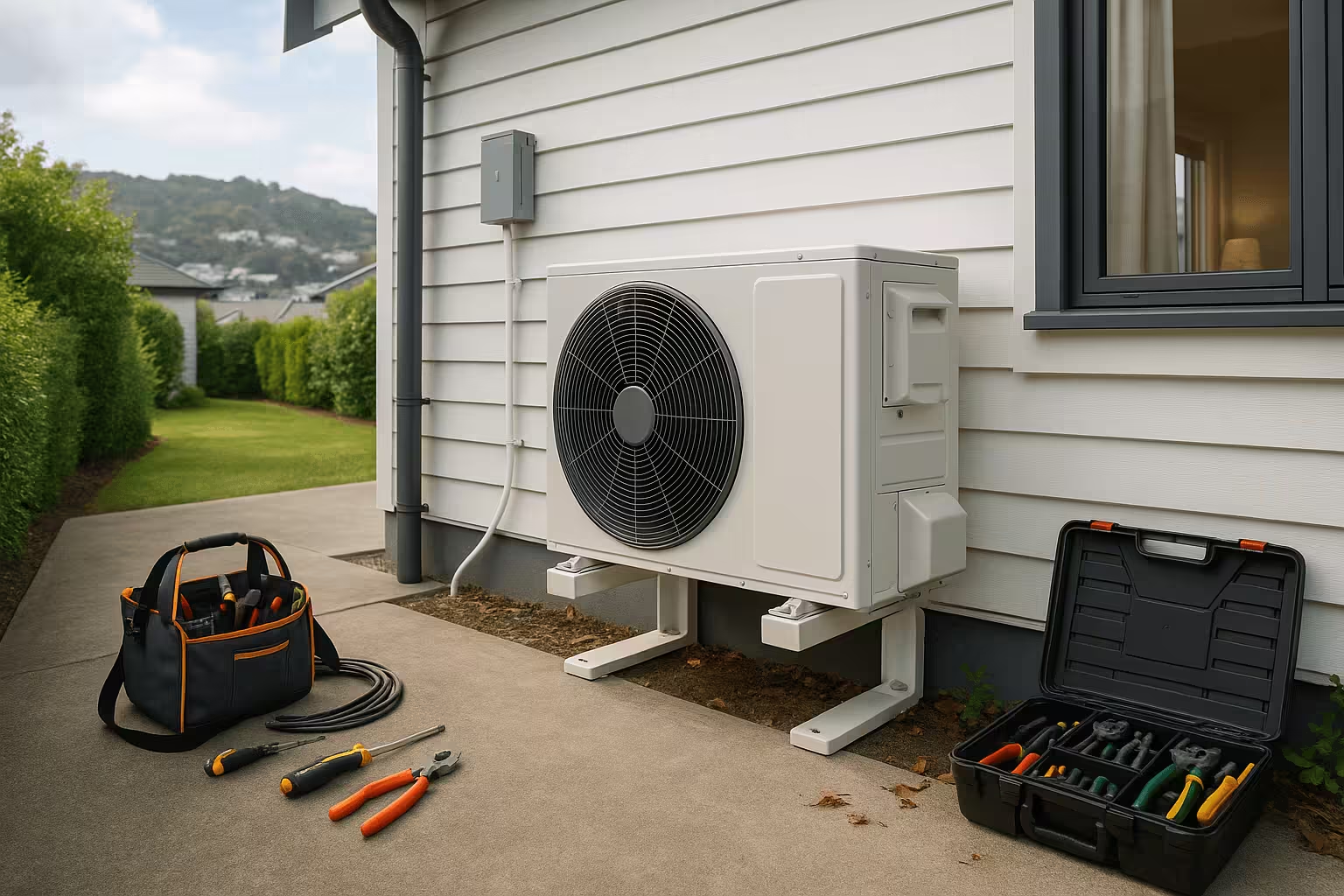To install a heat pump at home, you need to carefully select the location, secure professional assistance, and ensure all safety measures are followed. Installing a heat pump involves electrical work, positioning the unit, and connecting it to your home’s system.


Get A Free Quote
In the upcoming section, we’ll delve into the most frequently asked questions regarding how to install a heat pump, providing further insights to help you make an informed decision about your heating needs.
- Introduction
- Section 2: Selecting the Right Heat Pump for Your Home
- Preparation and Installation Process
- Why Choose Weka Electrical for Expert Heat Pump Installation
- Frequently Asked Questions
- Why should I install a heat pump in my home?
- How do heat pumps work?
- What are the main benefits of installing a heat pump?
- Where is the best place to install a heat pump in my home?
- Can I install a heat pump myself?
- How do I maintain a heat pump?
- What is the cost of installing a heat pump in Wellington?
- How long do heat pumps typically last?
Why Install a Heat Pump?
The need for efficient heating and cooling solutions is more critical than ever as we face fluctuating temperatures and climate change. Heat pumps offer an energy-efficient way to maintain indoor comfort, reducing reliance on traditional systems that consume more energy and subsequently cost more. By transferring heat rather than generating it, these systems can significantly cut down your utility bills while lowering your carbon footprint.Understanding Heat Pump Technology
A heat pump works on the principle of heat transfer, not unlike a refrigerator. During colder months, it extracts heat from the outside air and channels it inside your home. Conversely, in summer, it draws heat from your indoor space and releases it outside, providing a cooling effect. Modern heat pumps are equipped with reverse cycle capabilities, making them a versatile choice for year-round climate control. Before you delve into the technicalities of installation, it’s crucial to evaluate your home’s suitability for a heat pump system. Factors such as the size of your living space, insulation quality, and your local climate in Wellington will all influence the efficiency of the system you choose.Installation Considerations and Pitfalls
Installing a heat pump is not merely about placing the unit and plugging it in. It requires careful planning and execution to meet safety standards and ensure optimal performance. Key considerations include selecting the right model for your home’s requirements, finding the best location for efficient operation, and ensuring that the electrical connections are safely managed. Professional assistance from a qualified electrician, like those at Weka Electrical in Wellington, can make a significant difference in avoiding common installation pitfalls.
Selecting the Right Heat Pump for Your Home
Choosing the correct heat pump for your home is a pivotal step in ensuring optimal performance and energy efficiency. Not all heat pumps are created equal; therefore, it’s crucial to consider various factors such as the size of your home, the climate of Wellington, and your specific heating and cooling needs. By doing so, you can ensure that your heat pump not only meets your comfort requirements but also operates economically.Consider Your Home’s Size and Layout
The size and layout of your home significantly impact the capacity required of your heat pump. For larger homes, a heat pump with a higher capacity might be necessary, while smaller homes can benefit from a more compact model. Open floor plans may require different heat distribution strategies compared to multi-room homes, affecting the type or number of units needed. An incorrectly sized heat pump can lead to inefficiency, increased energy bills, and inadequate indoor climate control. Consulting with professionals at Weka Electrical can provide a tailored analysis that matches your specific needs.Climate Considerations in Wellington
Wellington’s climate, characterized by its breezy and occasionally chilly conditions, necessitates a robust heat pump system capable of efficient heating during colder months and effective cooling during summer. Selecting a heat pump with a good coefficient of performance (COP) ensures it operates efficiently despite external temperature variances. Models with inverter technology are particularly advantageous as they can modulate their output to match the temperature demands, providing consistent comfort while reducing energy consumption.Focusing on Energy Efficiency
Energy efficiency is a key factor when selecting a heat pump, not only for environmental reasons but also to keep operational costs manageable. Look for models with high energy star ratings and advanced features such as programmable thermostats and smart controls. These features can significantly enhance efficiency by allowing for better regulation of your home’s temperature. In a region like Wellington, ensuring your heat pump is energy efficient can translate into noticeable savings on your electricity bill, making it a wise investment in the long run.Consideration of Different Types
There are various types of heat pumps available, including air-to-air, geothermal, and water-source models, each with distinct advantages. For most homes in Wellington, air-to-air heat pumps are preferable due to their versatility and cost-effectiveness. However, geothermal heat pumps, though more expensive initially, offer greater efficiency by leveraging the earth’s constant temperatures. Evaluating these types in context with your home’s specific requirements is vital in making a well-informed decision. Having understood how to choose the right heat pump for your home, it’s time to delve into the steps involved in the preparation and installation process, ensuring a seamless and efficient setup.
Preparation and Installation Process
Installing a heat pump requires careful planning and execution to ensure efficiency and longevity. This section will delve into the step-by-step process to adequately prepare for and successfully install a heat pump in your home. Whether you’re taking a do-it-yourself approach or hiring professionals, these insights will help streamline the process.Assessment and Planning
Before you begin the installation process, conduct a thorough assessment of your home. This includes evaluating the area size, identifying optimal placement for both the indoor and outdoor units, and assessing structural support requirements. Ideally, the indoor unit should be placed in a central location to maximise airflow, while the outdoor unit should be located in a space with good air circulation, away from direct sunlight. Planning also involves understanding electrical requirements. Ensure that the electrical supply meets the heat pump’s power specifications, and consider consulting a qualified electrician to confirm compliance with local codes and standards. This step is crucial to prevent potential safety hazards and ensure that your system operates efficiently.Step-by-Step Installation Process
1. Mount the Indoor Unit: Begin by securely mounting the indoor unit bracket on a wall that can support its weight. Make sure it’s level to prevent operational issues. 2. Position the Outdoor Unit: Place the outdoor unit on a stable surface, ensuring it’s level. Use anti-vibration mounts to reduce noise and wear. 3. Connect Piping and Wiring: Carefully connect the refrigerant piping and wiring between units, following the manufacturer’s guidelines. It’s crucial to ensure that all connections are secure to prevent leaks and electrical faults. 4. Test the System: Once everything is connected, test the system to ensure proper operation. This includes checking refrigerant levels, testing electrical connections, and verifying that the airflow is unimpeded. Completing these steps not only guarantees a successful installation but also sets the foundation for long-term performance and comfort.Common Installation Challenges and Solutions
Even with careful preparation, you may encounter challenges during the installation process. One common issue is incorrect electrical supply, which can lead to system malfunctions. Address this by enlisting a professional electrician from the outset who can help identify and rectify any electrical mismatches. Another challenge is improper piping and wiring connections. Avoid mistakes by thoroughly reviewing the manufacturer’s instructions and ensuring that each connection is secure. Additionally, investing in a manifold gauge set can be worthwhile for testing refrigerant pressure and ensuring system efficiency. By anticipating these challenges and preparing solutions in advance, you can significantly minimise installation disruptions and set up a heat pump system that enhances your home’s comfort and energy efficiency. This meticulous approach to installation ensures your heat pump will function optimally, providing comfort and efficiency in your home for years to come. With the preparation and installation process clearly outlined, it’s time to consider why choosing a professional service like Weka Electrical can further enhance your experience.Why Choose Weka Electrical for Expert Heat Pump Installation
When it comes to ensuring that your home’s heating system is installed with precision and expertise, selecting the right service provider is paramount. Weka Electrical, based in Wellington, New Zealand, stands out as the top choice for those looking to install a heat pump efficiently and reliably. With years of local experience and a strong commitment to customer satisfaction, Weka Electrical has built a reputation that is hard to beat.Experienced Local Experts
One of the key reasons to choose Weka Electrical is their deep understanding of the local Wellington climate and infrastructure. Their team of electricians is not only fully qualified but also familiar with the unique challenges and requirements that come with installing heat pumps in this region. This local expertise ensures that your installation will be performed with the highest level of proficiency and reliability. Moreover, Weka Electrical takes a personalised approach to every project. Whether you are installing a heat pump in a modern apartment or a historic house, their team tailors solutions to meet your specific needs, ensuring optimal energy efficiency and comfort.What Sets Us Apart
Weka Electrical prides itself on its exceptional customer service and transparency. From the initial consultation to the final installation, they keep you informed and involved, making the process as smooth and hassle-free as possible. Their dedication to quality is evident in their use of premium materials and advanced techniques, offering peace of mind that your investment is protected for the long term. Their commitment to client satisfaction is reflected in numerous positive testimonials from satisfied customers who have experienced their outstanding service first-hand. Choosing Weka Electrical means choosing reliability, professionalism, and expert advice every step of the way. Additionally, Weka Electrical is well-regarded for their after-care support, providing guidance and assistance long after the installation is complete, helping to maintain the performance and longevity of your system. Whether you require a standard installation or have specific requirements, their flexibility and willingness to go the extra mile set them apart from other providers. See how they stay ahead in the industry and maintain a high standard of excellence.Get A Free Quote
In the upcoming section, we’ll delve into the most frequently asked questions regarding how to install a heat pump, providing further insights to help you make an informed decision about your heating needs.





